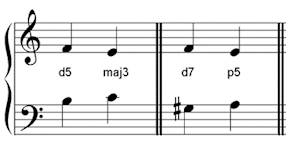Aug/Dim Melodic Intervals
If the interval between one note and the next in a tune is an augmented or diminished interval, the interval is dissonant and needs to be treated with careful voice leading. The word “dissonant” is often used in a negative way, to say a sound is harsh, but most interesting music does use dissonant sounds, just in a controlled way. In this lesson we will learn how to control these dissonances.

In a major key piece, the only augmented melodic interval that can appear is between the subdominant and the leading note, for example F rising to B in the key of C major. F to B is an augmented 4th.

In a minor key piece, there are a lot more places where augmented intervals can occur, for example between the mediant and the leading note, (C to G# in A minor) or between the submediant and supertonic (F to B). The most common appearance is the step between the submediant and the leading note (F to G#).

Usually, all augmented intervals should be avoided when you write a tune, whether the tune is in the soprano, bass, or an inner part. The melodic minor scale notes can be used to make sure that the augmented 2nd doesn’t occur. When the tune is rising to or falling from the tonic, you can raise the submediant and leading note by a semitone. If the tune is falling, you can leave both notes unraised.

So, generally speaking, you should avoid augmented melodic intervals. But there are some exceptions to this rule.
In some classical pieces, an augmented interval might appear as part of an arpeggio or scale based melody. For example, this extract from Mozart’s Sonata in C minor K457 uses augmented 2nds (Db to E) because the bar is based on a diminished 7th chord.

If the style of the whole piece is based on a dissonant interval, then they cease to be a problem. Music which is based on scales that are not major or minor often use lots of augmented intervals, and this is particularly true in middle Eastern styles and jazz. A famous example is the song “Maria” from West Side Story by Leonard Bernstein. The opening two notes form an augmented 4th, and this interval is repeated all the way through the song.

Diminished intervals are a softer kind of dissonance. Diminished intervals occur wherever the notes in an augmented interval are reversed, so for example B rising to F in C major or A minor, or G# to F or to C, in A minor.

If a diminished melodic interval is used, the best way to continue is to resolve the dissonance by moving by a step in the opposite direction.
B moves up to F, then down E. G# moves up to F then down to E, or G# moves to C then B.

All of these examples have been with rising intervals. What happens if the notes are falling? Well, the rules are the same. Remember, we always work out intervals from the lower note of the pair.

B falling to F is an augmented 4th, so it should be avoided. F falling to B is a diminished 5th, so it’s fine to use, but needs to be resolved by moving upwards to C. G# falling to F is an augmented 2nd, so best avoided. F falling to G# is a diminished 7th, and needs to rise to A to resolve.
Aug/Dim Harmonic Intervals
When augmented or diminished intervals occur as harmonic intervals, (between two parts which are playing at the same time), both notes need to resolve by step.
Diminished harmonic intervals should move inwards by step (to a smaller interval).
For example, a diminished 5th will move inwards to a major or minor third, and a diminished 7th will move inwards to a perfect 5th:

Augmented harmonic intervals should move outwards (to a larger interval). (Unlike augmented melodic intervals, augmented harmonic intervals are fine to use, as long as they resolve correctly).
For example, an augmented 4th will move outwards to a major or minor 6th:
